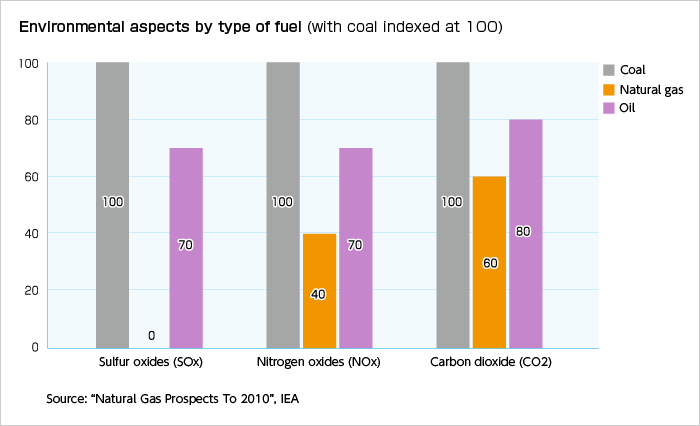Fuel for Thermal Power Generation
 Types of fuel
Types of fuel
KEPCO uses fossil fuels, LNG, (liquefied natural gas) coal and crude oil for our thermal power generation.
LNG
[Features]
- ・LNG is pressurized natural gas cooled to a temperature of –160°C and condensed, reducing its volume to one-600th.
- ・Because LNG is maintained at a very low temperature, it requires special storage tanks and specialized tanker ships.
- ・One LNG tanker from Qatar (about 90,000-ton capacity) can serve the electricity needs of about 2.1 million households/month.*
- ・LNG, a relatively clean hydrocarbon, generates fewer CO2 emissions and nitrogen oxides during combustion than do other hydrocarbons.
*Assuming monthly electricity consumption of 300kWh/household
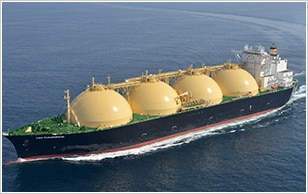
Power stations using LNG as the main fuel
- Himeji No. 1 Power Station
- Himeji No. 2 Power Station
- Nanko Power Station
- Sakaiko Power Station
- Kansai International Airport Energy Center
Coal
[Features]
- ・ Coal is classified by application as either fuel coal or coking coal; the coal used for power generation is classified as fuel coal.
- ・Because the calorific value per unit of weight is relatively low, large-scale boilers are necessary for effective combustion. Because coal is in solid form, conveyers are required to transport it, thus increasing the cost of facilities.
- ・One coal carrier vessel (about 85,000-ton capacity) can serve the electricity needs of about 1.05 million households/month.*
- ・Because it has a high nitrogen and sulfur content, it imparts a larger environmental impact during combustion than other fossil fuels.
*Assuming monthly electricity consumption of 300kWh/household
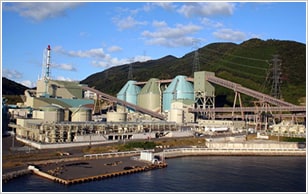
Power stations using coal as the main fuel
- Maizuru Power Station
Crude Oil
[Features]
- ・Crude oil is transported from oil-producing regions to domestic crude oil depots by crude carrier (about 100,000-kL capacity). From there, the crude oil is distributed to power stations by coastal crude carrier (about 5,000-kL capacity).
- ・Crude oil is easier to transport and store than are LNG and coal. In addition, there is more flexibility in procuring crude oil. On the other hand, the cost of crude oil is higher than that of LNG and coal.
- ・One coastal crude carrier (about 5,000-kL capacity) can serve the electricity needs of about 73,000 households/month.*
- ・In order to satisfy environmental regulations applicable to power stations, KEPCO use mainly super-low-sulfur crude oil (with a sulfur content not exceeding 0.1%) to ensure fewer sulfur oxide emissions. Heavy oil is also used as a combustion aid.
*Assuming monthly electricity consumption of 300kWh/household
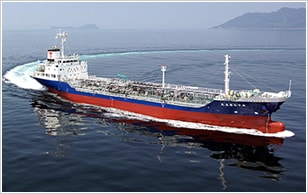
Power stations using crude oil as the main fuel
- Kainan Power Station
- Gobo Power Station
- Tanagawa No. 2 Power Station (Under a long-term planned outage)
 Fuel Comparison
Fuel Comparison
Each of the fuels used for thermal power generation have distinct advantages and disadvantages. KEPCO uses these fuels in combination in order to realize the maximum benefit of each type of fuel.
Characteristics of various fossil fuels
| Cost | Flexibility of procurement | Environmental aspects | Current role in KEPCO’s power generation mix | |
|---|---|---|---|---|
| LNG | ○ | △ | ◎ |
LNG, which is economic next to coal and has environmental advantages over coal, is used for base-to-middle load power generation. |
| Coal | ◎ |
○ | △ | Coal is the most economical fuel and is used for base-load power generation. |
| Crude Oil | △ | ◎ |
○ | Crude oil can be procured with greater flexibility and is used for middle-to-peak load power generation. |
Cost
The chart below shows that coal is the lowest-cost fuel, followed by LNG and crude oil. As can be seen from the chart below, coal is the cheapest fuel, followed by LNG and crude oil. At KEPCO, to supply power as affordably as possible, we give operational priority to power plants that use the cheapest fuel, and constantly monitor trends in international energy prices to ensure that we can procure fuels as economically as possible.
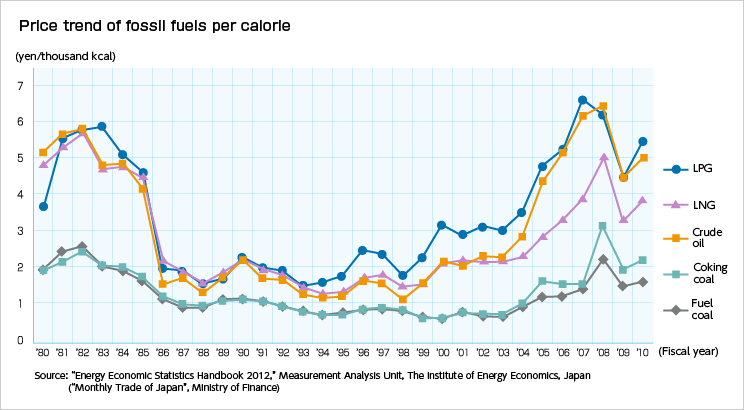
Flexibility of Procurement
As a fuel with high storability and shorter contract terms, crude oil can be considered a highly flexible fuel that can accommodate increases and decreases in the quantity required. Crude Oil is easy to store and many crude oil supply contracts have a short term, resulting in high flexibility. LNG, on the other hand, is somewhat troublesome to store and has lower flexibility because LNG contracts tend to be longer term. In consideration of these characteristics, KEPCO procures fuels that enable it to respond appropriately to electricity supply and demand.
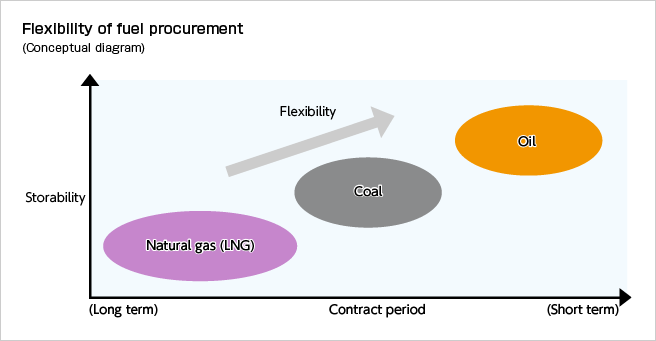
Environmental aspects
The environmental load of the various fossil fuels ranks, in increasing order, LNG (natural gas), crude oil, and coal. LNG is considered a relatively clean fuel. KEPCO constructs its generation facilities with full consideration for the environmental aspects. Our energy mix is aimed at achieving "S + 3E.”*
*An abbreviation for “safety + energy security/economy/environmental conservation.” It represents our dedication to creating an energy mix that contributes to long-term energy security, good economic value, and environmental conservation, all premised on a commitment to assured safety.
